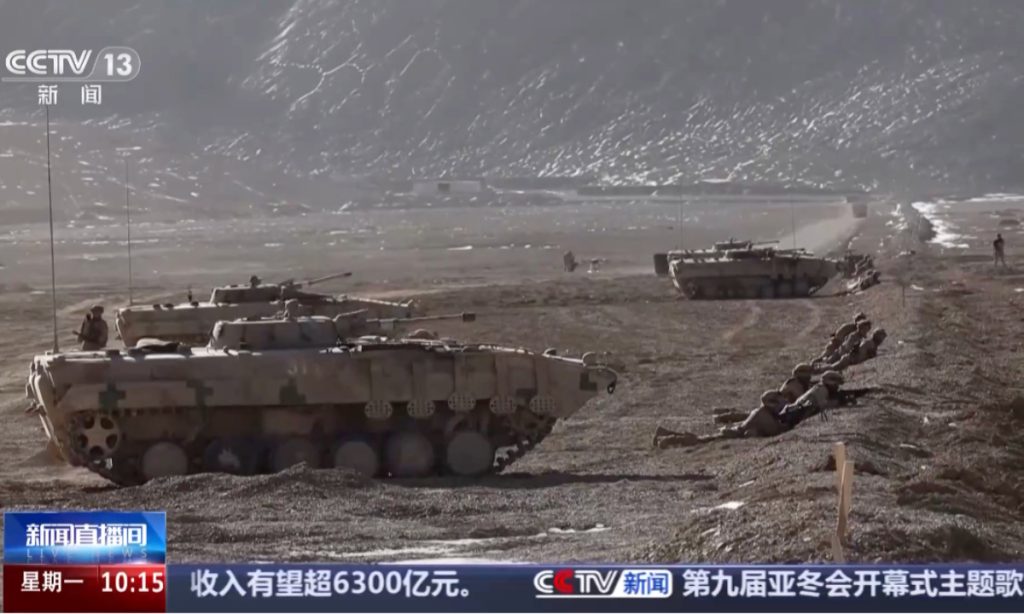PLA Army carries out drills to test operational capacity in high-altitude and cold environment conditions

The Chinese People’s Liberation Army’s (PLA) Army has carried out joint drills to evaluate annual combat readiness in high-altitude and cold environment conditions in the Karakoram Mountains at the start of the new year, featuring drones, tanks and infantry fighting vehicles.
According to a China Central Television (CCTV) report on Monday, a unit of the Xinjiang Military Command has been conducting reconnaissance tactical drills in an unfamiliar high-altitude area. Multiple forces of reconnaissance, armored and firepower units participated with a range of equipment to test their operational capacity.
In the Karakoram Mountains during the ongoing drills, the reconnaissance unit swiftly maneuvered to the designated area and established a reconnaissance position upon after receiving intelligence from a higher command. Meanwhile, the aerial reconnaissance unit deployed drones to conduct real-time battlefield monitoring.
The command post quickly analyzed the enemy situation and issued combat orders, with all operational units immediately responding. The armored unit swiftly assembled, mobilized their vehicles, and launched an assault on the forward positions. The artillery unit adjusted firing parameters as instructed, preparing for fire support.
According to a participant of the exercise, due to rapidly changing battlefield conditions, the reconnaissance unit must be stealthy, efficient and swift when carrying out missions, which requires the unit not only to possess strong military skills but also to be familiar with the terrain and topography of the battlefield.
The CCTV report shows that as the drills continued, the reconnaissance unit advanced the frontline rapidly, using radar systems, drones and telescopes to conduct comprehensive detection of the enemy’s forward positions.
After obtaining information on enemy troops’ deployments and firepower configurations, an assault group formed by the armored unit launched successive charges. Under the cover of tanks, troops carried by infantry fighting vehicles quickly dismounted and advanced toward the target area, successfully seizing the position.
In accordance with the operational requirements for high-altitude and cold regions, the troops have researched system-based reconnaissance, said Zhou Hongxin from the Xinjiang Military Command. Through targeted enhancement and gap-filling trainings, and repeated rounds of combat drills, each combat unit could spot their shortcomings, which compels PLA soldiers and officers to address and overcome deficiencies, thereby enhancing overall ability.
This year’s military drills officially began on January 2 with all military troops carrying out exercises throughout the country, from the Gobi Desert, the coastal frontlines, the snow-covered plateaus to the dense mountain forests.
On Thursday, drills of a destroyer detachment from the navy of the PLA Southern Theater Command began in full swing. A formation of advanced destroyers and frigates cast off and set sail for designated waters to conduct a series of high-intensity, combat-oriented drills, according to CCTV.
Meanwhile, an air force aviation brigade conducted its first training flight at the beginning of the new year, integrating aerial tactical competitions into their drills. Pilots engaged in realistic combat scenarios, carrying out air combat confrontations, close-range air support, and air-to-ground attack drills across multiple training subjects. The training aims to comprehensively hone the pilots’ combat skills in a simulated battlefield environment, CCTV reported.
Song Xiaojun, a military affairs commentator, said the highlights and characteristics of different services in diversified drills can be summarized with three phrases – actual combat, high intensity and systematization.
Song said that this year’s New Year drills are related to deepening the reform of the joint operational system, which means that different military services and branches should find points of closer interdependence in future operations. Only in this way can they achieve the maximum effect of joint operations and, in turn, constrain the enemy’s decision-making space to force them into difficult situations, CCTV reported.